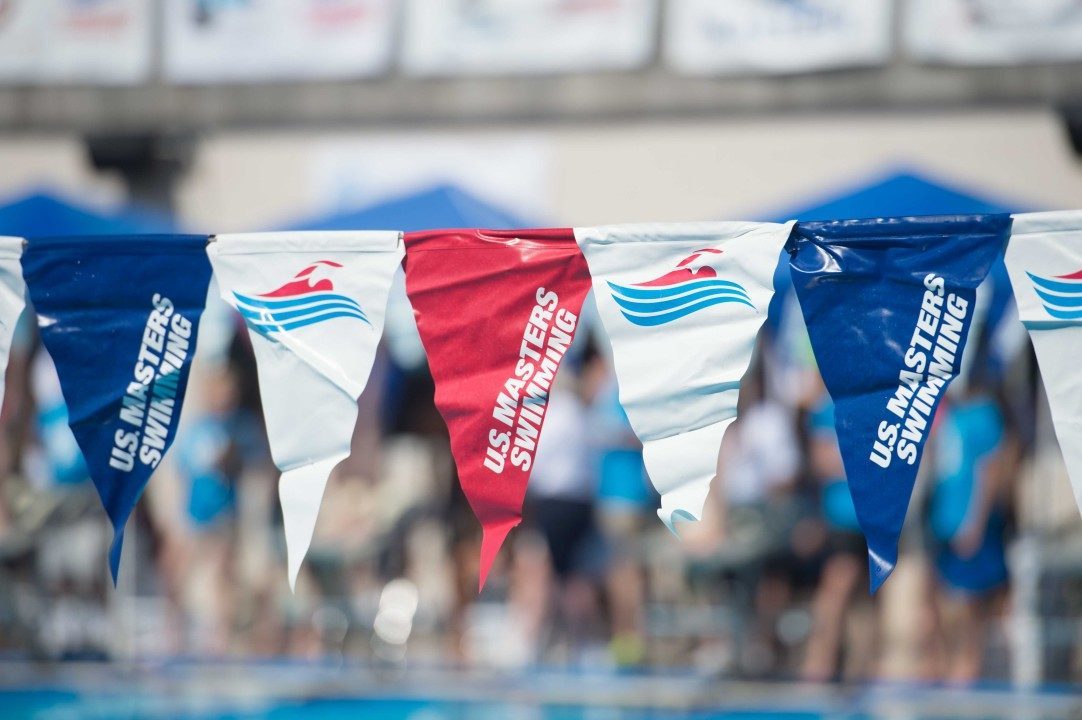Courtesy: Daniel Paulling / U.S. Masters Swimming
Backstroke can be a difficult stroke to swim. Many backstrokers struggle with a lack of body rotation that keeps their stroke long and efficient or crossing over on their entry.
To help you swim like a national champion, here are tips from two swimmers who won national championships in the 200 backstroke on Friday, the second day of the U.S. Masters Swimming Long Course National Championship at the SPIRE Institute in Geneva, Ohio.
Swim With a Band
Ondrej Maxian finished swimming at Case Western Reserve University in 2018 with a new perspective on his sport. After swimming fast in middle and high school, he says, he plateaued in college and wearied of competing. He figured he should swim for the love of it, not for times.
He began doing Masters swimming after college but felt an urge to compete again after about a year. He’s kept competing, leading to his winning the men’s 25-29 200 backstroke with a time of 2:21.23.
One key to his success has been swimming backstroke with a band around his ankles as a way to focus on his body rotation. With the band in place, he says, backstrokers must place added emphasis on rotating their hips and shoulders to maintain an efficient and long stroke.
“Your shoulders and your hips, that’s where all the action is,” Maxian says.
He has found this drill also helps him work on his stroke rate and catch, and also recommends using paddles while doing this drill for added emphasis on improving your catch.
Maxian, 25, usually does a set specifically for his 200 backstroke once a week, alternating 4 x 50s pull with a band and a descending number of 200s backstroke, starting with four and going down to one, on a descending interval. (His first four are on 3:00, the next three on 2:50, and so on, intervals that he can make by about five to 10 seconds.)
The Colonials 1776 member says making the final 200 on 2:30 in long course meters (or 2:10 in short course yards) gives him a sense of accomplishment.
“I’ll be, like, ‘Yeah, that was good,’” Maxian says, “and I feel good for the rest of the day.”
Double-Arm Backstroke
When Kelly Harrigan showed up for a Mesa Aquatic Club–Masters workout in 2010, the coaches asked her if she had any swimming experience. She replied that she had some.
Consider that an understatement. Harrigan swam at Rutgers University, was a member of the U.S. National Team, and had kept swimming while attending veterinary school. She loves her decision to join her club.
“We have a really fun team,” Harrigan says. “When I started, they said our mascot is a narwhal. A fat, happy kind of mythical creature. What could go wrong?”
Harrigan continued swimming, leading to her winning the women’s 35-39 200 backstroke with a time of 2:25.80, her second national championship on Friday. (She also won the 100 butterfly.)
Harrigan, 37, keeps her backstroke in tip-top shape by doing double-arm backstroke drill in every workout, usually for 100 or 200 yards/meters. The drill ensures her hands are entering in the proper position, which is directly in front of her shoulders.
The drill helps correct a common problem for backstrokers: crossing over on their entry, or having their hands enter across the centerline of their body. This improper entry leads to swimmers pushing their hands out to the side, causing them to wiggle down the lane, and keeps them from getting a powerful and quick catch.
Harrigan does a lot of backstroke during her workouts, which helps her develop the endurance needed to swim the 200 backstroke. But doing so much backstroke in workouts causes her to get tired and perform improper technique, which doing double-arm backstroke helps fix.
“I do double-arm backstroke hopefully before there starts to be a concern about [crossing over],” Harrigan says.
Records Broken on Day 2
- Shirley Loftus-Charley, Virginia Masters: women’s 70-74 400 IM (7:13.95, USMS record)
- Lawrence Day, Michigan Masters: men’s 70-74 100 butterfly (1:07.40, FINA Masters world record and USMS record)
- Laura Val, Tamalpais Aquatic Masters: women’s 100 butterfly (1:16.07, FINA Masters world record and USMS record)
- Diann Uustal, Sarasota Sharks Masters: women’s 75-79 50 freestyle (34.11, FINA Masters world record and USMS record)
- Laura Val, Tamalpais Aquatic Masters: women’s 70-74 200 backstroke (2:49.43, FINA Masters world record and USMS record)
- David Guthrie, Rice Aquatic Masters: men’s 60-64 100 breaststroke (1:11.72, FINA Masters world record and USMS record)
Note: All records are subject to change pending verification.

Love this coverage of Masters nationals! More Masters content, please 👍
some amazing swims! and a good reminder to folks in their mid 20s-mid 30s that, no, they really don’t feel ‘old’ 🙂
But seriously, this is the fun of masters swimming — the amazing stories and backgrounds teammates have.
Daniel is fantastic at bringing these stories to our attention!
Laurie Val time in 100 meter fly for a 70 is out of this world. same goes for the 200 backstroke.